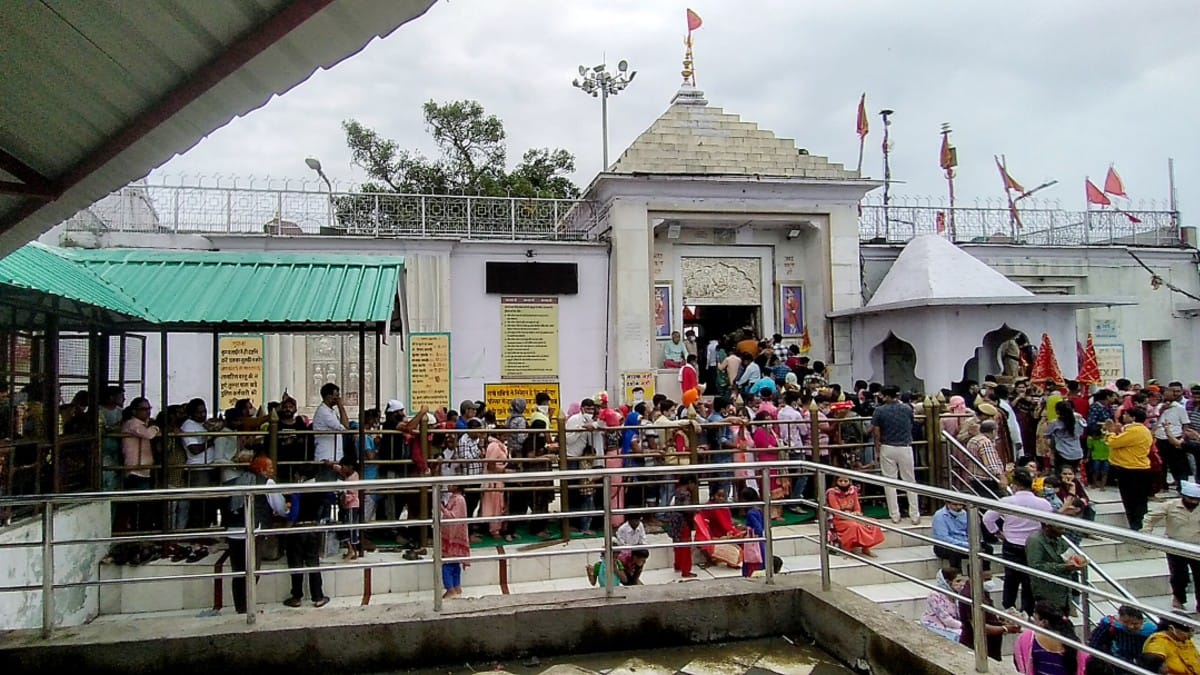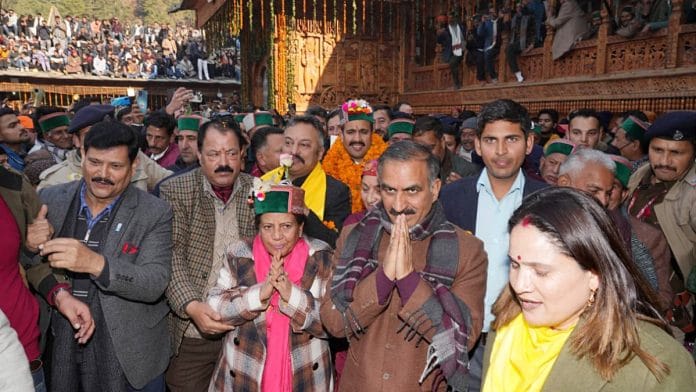Shimla: A decision by the Congress government in Himachal Pradesh to seek voluntary financial contributions from state-controlled temple trusts for its flagship welfare schemes may have handed the state BJP a “potent weapon” to attack the ruling party with and to claim an assault on Hindu sentiments.
“Congress disrespects Sanatan Dharma yet shamelessly milks its institutions,” Leader of the Opposition in the Assembly and former chief minister and Jairam Thakur posted on X Thursday. The Congress dismissed the allegation as “politically motivated”.
The controversy erupted after a 29 January directive asking temple trusts under the Himachal Pradesh Hindu Public Religious Institutions Charitable Endowments Act, 1984, to voluntarily contribute to ‘Mukhyamantri Sukh-Aashray’ and ‘Mukhyamantri Sukh Shiksha’.
The two schemes focus on aiding orphans, destitute women, and underprivileged children. Adding fuel to the fire is the government’s instruction to all Deputy Commissioners (DCs), who are also temple commissioners, to facilitate these contributions.
Quick to react, the state BJP accused the Sukhvinder Singh Sukhu-led Congress government of misusing sacred funds even as the incumbent defended it as a legitimate call for voluntary support amid a crippling financial crisis in the state.
Also Read: HP govt tasks universities with studying cannabis cultivation, assessing medical & industrial uses
Clash of narratives
Calling it “an unprecedented overreach,” Thakur said in a statement, “This is shocking and unacceptable. No government has ever tapped temple funds for regular budgetary schemes.”
He added, “On the one hand, the Sukhu government opposes Sanatan Dharma with anti-Hindu rhetoric; on the other, it seeks to siphon off temple donations to prop up its administration. We will fight this tooth and nail, both inside and outside the Vidhan Sabha.”
सुक्खू सरकार एक तरफ सनातन धर्म का विरोध करती है, हिंदू विरोधी बयान देती रहती और दूसरी तरफ मंदिरों से पैसा लेकर सरकार की फ्लैगशिप योजना चलाना चाह रही है।
सरकार द्वारा मंदिरों से पैसा मांगा जा रहा है, अधिकारियों पर दबाव बनाया जा रहा है कि जल्दी से जल्दी पैसा सरकार को भेजा जाए।… pic.twitter.com/lxa09YtHke
— Jairam Thakur (@jairamthakurbjp) February 27, 2025
Thakur’s accusations come ahead of the state’s budget session beginning March 10. Citing a letter from a departmental secretary demanding swift transfers of funds to the state treasury, he alleged that district administrations are pressurising temple trusts to comply.
Meanwhile, Himachal Pradesh Congress chief Pratibha Singh defended the initiative, emphasising its voluntary nature and humanitarian intent. “Our government is running these schemes for a noble cause—to uplift helpless children, provide them education and a better life,” Singh told reporters in Shimla Saturday. “We’ve appealed to everyone, not just to temples, to contribute. The BJP’s allegations are baseless and politically motivated.”
Revenue Minister Jagat Singh Negi echoed Singh’s sentiments, pointing to the precedent under the BJP rule. “Why is it wrong to seek donations for welfare? Even the previous BJP government accepted temple contributions during the COVID-19 crisis,” Negi told ThePrint, referring to a Rs 25 lakh donation from the Kali Bari Mandir in 2020.
Temple wealth
There are at least 36 major temples under the state’s control in Himachal Pradesh besides several other smaller trusts. While the revenue managed by the trusts is anyone’s guess, Vidhan Sabha records from the 2023 monsoon session estimate that they collectively hold assets and annual offerings worth hundreds of crores of rupees.
The Chintpurni temple in Una district and the Naina Devi temple in Bilaspur district attract millions of devotees annually, generating significant donations.

A 2022 government report by the state’s language, art and culture department pegged the combined cash reserves and gold holdings of major temples at over Rs 500 crore, though officials caution that much of this is earmarked for maintenance, rituals, and charitable activities.
The state’s financial distress adds urgency to the debate. Reeling from successive natural disasters, including floods and landslides that caused damages exceeding an estimated Rs 10,000 crore in 2023, Himachal Pradesh has struggled to pay salaries and pensions to government employees. Last August, Chief Minister Sukhvinder Singh Sukhu and his cabinet members decided to defer their own salaries for two months.
The Congress government in the state has also accused the BJP-led central government of withholding Rs 2,500-3,500 crore in pending GST dues, adding to the strain on its coffers. Its attempts to secure special relief from the Centre by having it declare Himachal as a disaster-struck state have also been unsuccessful.
A former deputy commissioner, now overseeing a state department, confided to ThePrint on condition of anonymity: “In the past, DCs were directed to channel temple funds to CM’s Relief Fund, typically during natural disasters. But this is unprecedented—seeking contributions for specific schemes like Sukh-Aashray and Sukh Shiksha. Still, under the Act, it’s legally sound.”
Any proposal on contribution must first be approved in a trust meeting, as per provisions under Section 17 and its subsections (a) to (d) of the Act. Under Section 17, including 17(a) and 17(b), of the Act, a trustee may use funds, after fulfilling the institution’s primary purposes like puja and rituals, to (a) promote Hindu religion and faith as per the institution’s tenets, and (b) establish and maintain educational institutions.
Monetising gold offerings
A September 2024 amendment to the 1984 Act, further complicates the matter.
According to the amendment, temple trusts can monetise a portion of their gold offerings—provided it is not part of deity adornments or a heritage artefact—for “charitable purposes” approved by the chief commissioner of temples, a post held by the secretary (language, art and culture department).
Critics argue that this opens the door to government overreach, though the state administration insists it ensures compliance with legal safeguards and approvals by trust boards.
“This amendment isn’t about looting temples—it’s about enabling them to support societal good while adhering to strict regulations,” said a senior official in the state government’s social justice and empowerment department, speaking on condition of anonymity.
Observers, meanwhile, see the controversy as a symptom of deeper fiscal woes. “Himachal’s economy is on life support, and the government is clutching at straws,” said Ajay Sharma, a political commentator based in Shimla. “But tapping temple funds is a risky gambit—it alienates a devout electorate and hands the BJP a potent weapon.”
(Edited by Sudha V.)
Also Read: Protests erupt in Himachal Pradesh over ‘betrayal’ as Sukhu govt revives Guest Teacher Policy






